There is one scrum half in the starting fifteen players on a Rugby Union team. Scrum halves wear the nine jersey and are often the smallest players on the pitch.
They are sometimes called “half backs” along with fly halves, and we’ll explain why in this article.
This article describes the role of a scrum half in the fifteen-player sport. If you’re interested in Rugby Sevens, check out our article on scrum halves in sevens rugby.
Why Are They Called Scrum Halves?
The reason for the name “scrum half” comes from how rugby evolved from its early history.
In the early 19th century days, the sport had two specialist positions. Everybody was either a forward or a back, and most players were forwards.
Introduction of half backs
The next phase split the backs into two types: the fullbacks who were furthest away from the scrum and a few half backs who stood nearer to it.
The term “half back” is still used today to describe the combination of scrum half and fly half. Both players are half backs.
Before the number of players was set to fifteen in 1877, there could be twenty players per team on the field.
A twenty-player team could have three half backs, one centre, and three full backs in the back line. That was the lineup when England played Scotland in 1871.
With the reduction in numbers, teams now played two half backs. One was nearer the scrum to feed the ball between the front rows and collect it from the back.
How scrum halves got their name
Now you can see how scrum halves got their name. They are simply the half back that is nearest the scrum.
In this overhead, you can see that the forwards have just packed down and the referee (in orange) is waiting for the scrum to be stable.
The team that is awarded the scrum gets to feed the ball into it. In this case, the England scrum half is holding the ball and waiting for the referee to give the call to put it in.
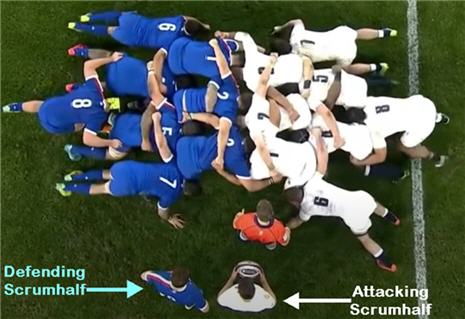
What happens next? Read on…
What Does A Scrum Half Do At The Scrum?
Scrum halves are not part of the scrum, but their role is crucial. For the team in possession of the ball, the scrum half’s role is to:
- feed the ball into the scrum
- collect the ball from the back of the scrum
- break, pass, or kick to start the attacking play
Let’s take a closer look.
Feeding the ball
When the two sets of forwards pack down to scrum against each other, the scrum half feeds the ball into the middle.
In the screenshot below, England has the scrum. The England number nine has just fed the ball into the channel between the opposing front rows.
You can see the French defending scrum half watching from a short distance.
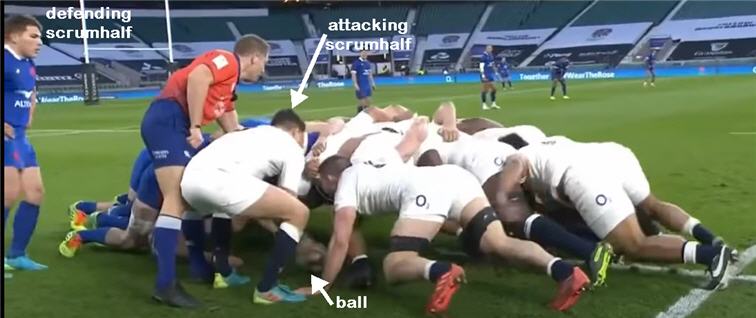
You’ll often see defending scrum halves creeping forward to try to harry their opposite number.
In the picture above, the French nine has his hands on hips with typical French nonchalance!
But Dupont is one of the best scrum halves in the world. He’s watching proceedings like a hawk.
Collecting the ball from the scrum
Teams have plenty of options to get the ball out from the back of the scrum.
This is coordinated between the scrum half and the number eight, who is the forward at the hindmost position of the scrum.
The number eight may pick it up and chuck a short pass to the scrum half who is running an arc around the back. That can give great momentum.
But the more classic scrum is less dynamic. The number eight keeps the ball nestled between his feet.
This means that the scrum hasn’t finished, and the opposition can’t advance until the scrum half picks up the ball.
pass, break, or kick
What the scrum halves do when they pick up the ball is often the start of a pre-planned play.
The fly half usually calls the play when the team is in a good attacking position.
The call may be for the scrum half to pass long to the out half. Or the call may be to pass short to a big centre to run hard at the defensive line.
Another exciting move is when the scrum half picks up the ball and tries to make a fast break past the flankers.
This is also known as sniping, especially when the scrum is close to the opposition line and the nine is gunning for a try.
When the team in possession is deep in their own half, the scrum half may kick the ball out of play.
What Does The Scrum Half Do At The Lineout?
Lineouts have become hugely important to attacking play in Rugby Union. In the 2015 World Cup, over half of the tries started with a lineout.
Scrum halves as receivers
There are all kinds of rules that determine how close players can stand near to the lineout.
There is a specific “receiver” position that allows one player to stand two meters back from the line ready to receive the ball.
The receiver is often, but now always, the scrum half.
Here’s a schematic with the receiver two meters away from the lineout.
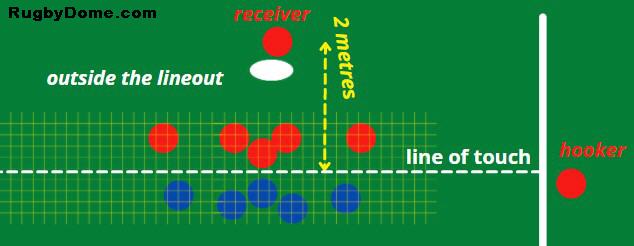
Here’s an overhead screenshot of the same situation, with the England nine waiting for the ball.
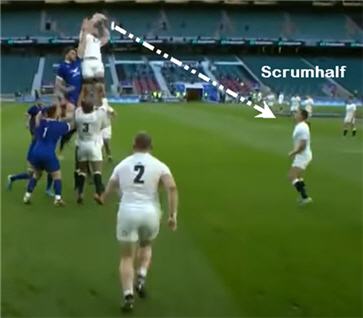
When the scrum half receives the ball, they now initiate the attacking play.
Usually The Smallest Position On The Field
We have a separate article on the average heights of professional rugby players by position.
Here is a summary that shows where the scrum halves fall in height ranges. As you can see, they tend to be significantly shorter than other positions.
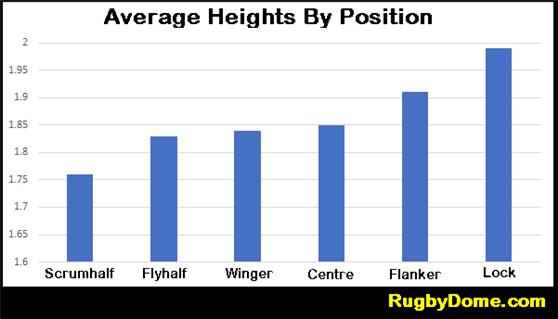
Of course, there are exceptions that are notable for sticking out!
Tall scrum halves
The late Springbok Joost van der Westhuizen is one of the greatest nines in history. He stood 1.88 m (or six foot two).
Welsh and Lions scrum half Michael Philips was an inch taller at 1.91m.
One of the tallest scrum halves playing currently is Conor Murray. The Irish international is 1.88m (6 ft 2in).
What Do Scrumhalves Do In Defense?
Scrum halves often act as sweepers in defense.
When a team is defending, most players spread out across the field in a single defensive line. However, the space behind this line must also be defended from kicks and breaks.
The scrum half often sweeps across the field behind the defensive line. They may make the first defensive tackle if the opposition break through the line.
The fullback and a wing will usually stand further back as the last players in defense.
Box Kicking
Box kicking has become a key skill for scrum halves in modern rugby.
Scrum halves will kick the ball high from behind rucks and scrums. Unlike a standard kick forward, the box kick may start with the player in a crouched position.
Scrum halves may be facing backward as they kick, which makes accurate kicking even more difficult.
You’ll find plenty of examples and some video in our article on box kicking in rugby.
Scrum half Passing Techniques
Because scrum halves are so often involved in initiating attacking plays, they have to be excellent passers off both hands.
They also master some of the more complicated passing techniques that we don’t expect a prop forward to pull off. These include:
- Reverse passes (feinting a pass one way and passing in the opposite direction)
- Short pop passes to onrushing forwards
- Long spin passes out to the wing
One technique that you won’t see anymore is the dive pass. It used to be an iconic scrum half move but has fallen out of fashion.
If you want full explanations of each of these techniques, check out our article on the many different types of passing in rugby.
Other Positions
Our high-level look at rugby positions and numbers has links to in-depth articles for each playing position.
Frequently Asked Questions About Scrum Halves
Here are some quick answers to common questions.
Who is the greatest scrum half in modern times?
Check out our article on the greatest scrum halves. You may be surprised by our selections!
What number is the scrum half?
The starting scrum half wears the number nine jersey.
The number worn by the substitute scrum half depends on the number of forwards on the bench. If there are five forwards, the sub scrum half wears 21.
The referee and commentators will still refer to the substitute scrum half as the “nine” if they come onto the field.
Is a scrum half a forward or a back?
Scrum halves are the link between forwards and backs. But which of these two categories do they fall under?
Scrum halves are part of the backs in a rugby team. A scrum half is the back who stands closest to the scrum.